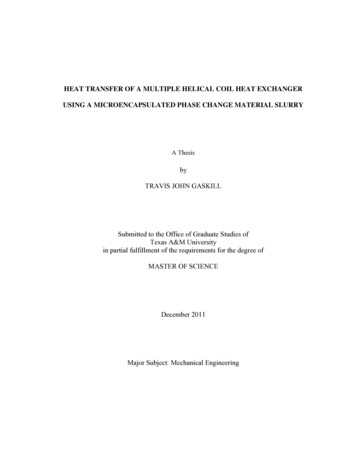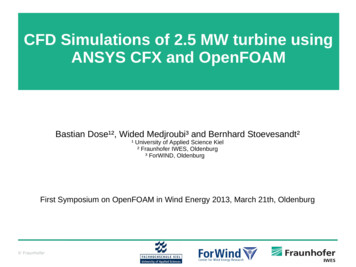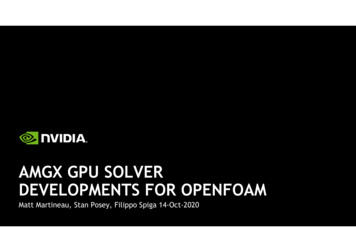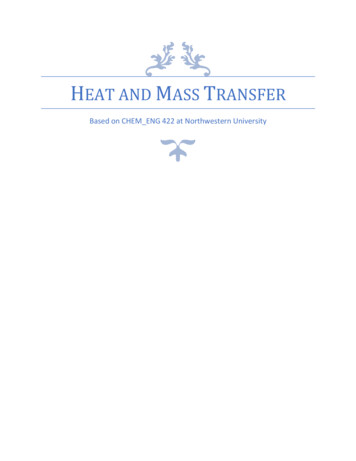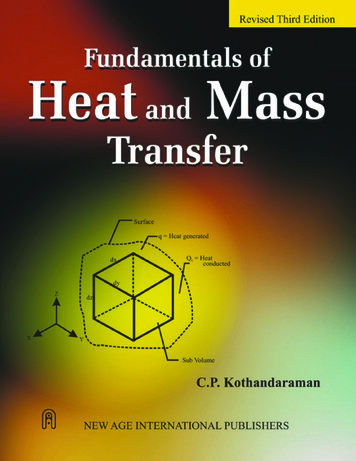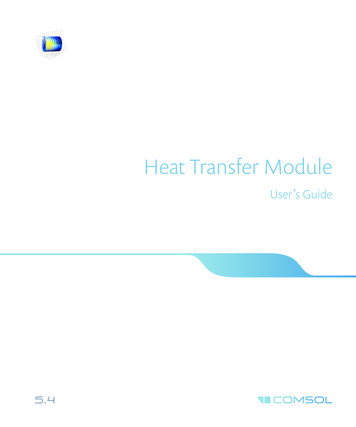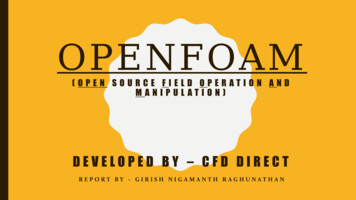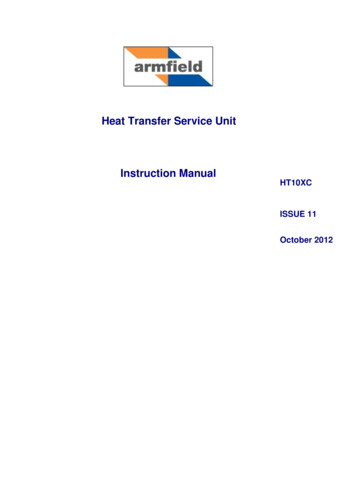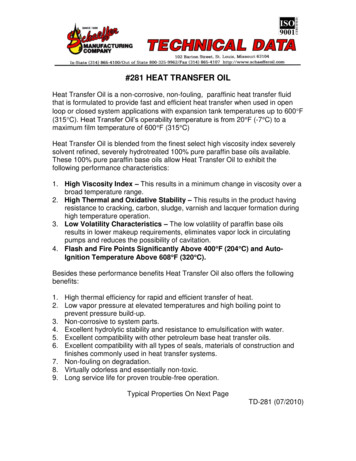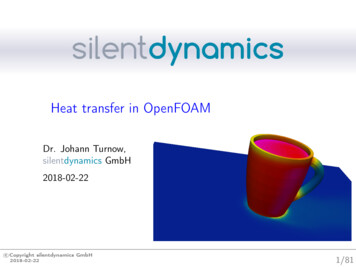
Transcription
Heat transfer in OpenFOAMDr. Johann Turnow,silentdynamics GmbH2018-02-22c Copyright silentdynamics GmbH2018-02-221/81
ContentsClassification Solver Conduction Convection CHT Radiation onc Copyright silentdynamics GmbH2018-02-222/81
Main heat transfer typesClassification Solver Conduction Convection CHT Radiation 1. Heat conduction2. Heat convection3. Heat radiationIsteady, transientIcompressible, incompressibleI.c Copyright silentdynamics GmbH2018-02-223/81
Solver overviewClassification Solver Conduction Convection CHT Radiation Overview of OpenFOAM solvers for heat transfer analysisIIIIlaplacianFoam:Transient, incompressible, thermal diffusion according to Fourier’slawscalarTransportFoam:Steady-state, incompressible, laminar, passive scalar e.g.temperature for a given velocity fieldbuoyantBoussinesqSimpleFoam:Steady-state, thermal, natural convection, incompressible,Boussinesq’s , thermal, natural convection, incompressible, Boussinesq’sapproximationc Copyright silentdynamics GmbH2018-02-224/81
Solver overviewClassification Solver Conduction Convection CHT Radiation Overview of OpenFOAM solvers for heat transfer analysisIIIIIbuoyantSimpleFoam:Steady-state, natural convection, compressible (sub-sonic), includingradiationbuoyantPimpleFoam:transient, natural convection, compressible(sub-sonic), includingradiationrhoSimpleFoam:Steady-state, thermal, , thermal, compressible(sub-sonic) -Pressure underrelaxiation 1rhoPimpleFoam:Transient, thermal, compressible(sub-sonic)c Copyright silentdynamics GmbH2018-02-225/81
Solver overviewClassification Solver Conduction Convection CHT Radiation Overview of OpenFOAM solvers for heat transfer analysisIchtMultiRegionFoam:Transient, compressible, conjugate heat transfer between solid andfluidIchtMultiRegionSimpleFoam:Steady-state, compressible, conjugate heat transfer between solidand fluidIthermoFoam:Transient, evolves the thermophysical properties for a frozen velocityfieldc Copyright silentdynamics GmbH2018-02-226/81
Heat conductionClassification Solver Conduction Convection CHT Radiation Basic solver: laplacianFoamISimple heat conduction equation according to Fourier’s law Tλ 2T tρcp x 2I(1)Take a look at the solverIIIcd FOAM SOLVERS or solcd basic/laplaciangedit laplacianFoam.Csolve(fvm::ddt(T) - fvm::laplacian(DT, T));c Copyright silentdynamics GmbH2018-02-227/81
Heat conductionClassification Solver Conduction Convection CHT Radiation Basic solver: laplacianFoamIDefine the heat diffusivity DT :Igedit constant/transportProperties//DT heatDT DT [ 0 2//DT DT [ 0//DT DT [ 0diffusivity-1 0 0 0 0 ] 1.6667e-05; //air2 -1 0 0 0 0 ] 0.144e-06; //water2 -1 0 0 0 0 ] 9.3e-05; //aluc Copyright silentdynamics GmbH2018-02-228/81
Heat conductionClassification Solver Conduction Convection CHT Radiation Example coffee cupIIIUsing laplacianFoam to simulation usual problemsLet’s try to analyze the temperature distribution in our coffee cupQuestion: Can you touch the cup without any pain?c Copyright silentdynamics GmbH2018-02-229/81
Heat conductionClassification Solver Conduction Convection CHT Radiation Example coffee cupSetting the boundary conditionsgedit 0/TinternalField uniform 273;boundaryField{sideWalls{type zeroGradient; //adiabatic}coffee{type fixedValue; // fixed Temperature b.c.value uniform 373;}}IIc Copyright silentdynamics GmbH2018-02-2210/81
Heat conductionClassification Solver Conduction Convection CHT Radiation Example coffee cupSetting the boundary conditionsgedit 0/TinternalField uniform 273;boundaryField{sideWalls{type zeroGradient; //adiabatic}coffee{type fixedGradient; //fixed heat flux b.c.gradient 10000;value uniform 373;}c Copyright silentdynamics GmbH2018-02-22}II11/81
Heat conductionClassification Solver Conduction Convection CHT Radiation Example coffee cupIDefine the heat diffusivity DT for alu:Igedit constant/transportProperties//DT heat//DT DT [ 0//DT DT [ 0DT DT [ 0 2diffusivity2 -1 0 0 0 0 ] 1.6667e-05; //air2 -1 0 0 0 0 ] 0.144e-06; //water-1 0 0 0 0 ] 9.3e-05; //aluIdecomposeParIfoamJob -parallel laplacianFoamItail -f logc Copyright silentdynamics GmbH2018-02-2212/81
Heat conductionClassification Solver Conduction Convection CHT Radiation Example coffee cupITake a look at the temperature after 2.0sec for our alu cupIThe alu gives pretty hot fingers after 2.0secc Copyright silentdynamics GmbH2018-02-22,13/81
Heat conductionClassification Solver Conduction Convection CHT Radiation Example coffee cupIComparison to a usual porcelain cupIThe porcelain cup gives us cool fingers fingers after 2.0sec and10.0sec (-:c Copyright silentdynamics GmbH2018-02-2214/81
Heat conductionClassification Solver Conduction Convection CHT Radiation OutcomeIIIIIIIILaplacian solver gives a fairly good overview for simple heatconduction problemsAlways the first choice for simple heat conduction solutionsFirst step: Think about which results you expectImportant to avoid nonphysical solutions . :-)Always take a look at the residualsAlways remember that the mesh resolution influences the results incase of heat transfer dramatically!A Priori: Which boundary conditions should be applied?Be careful with the constant heat flux boundary conditionc Copyright silentdynamics GmbH2018-02-2215/81
Heat convectionClassification Solver Conduction Convection CHT Radiation Which solvers can we use?IscalarTransportFoam for laminar, unsteady/steady flowsIbuoyantBoussinesqSimpleFoam:Steady-state, thermal, natural convection, incompressible,Boussinesq’s t, thermal, natural convection, incompressible, Boussinesq’sapproximation Set the gravitation to Zero for simple passive scalar flowsc Copyright silentdynamics GmbH2018-02-2216/81
Heat convectionClassification Solver Conduction Convection CHT Radiation Wich equation is solved?volScalarField alphaEff("alphaEff", turbulence- nu()/Pr alphat);fvScalarMatrix TEqn(fvm::div(phi, T)- fvm::laplacian(alphaEff, T) radiation- ST(rhoCpRef, T) fvOptions(T));c Copyright silentdynamics GmbH2018-02-2217/81
Heat convectionClassification Solver Conduction Convection CHT Radiation Let’s take a look at our cup!IQuestion: How much is the coffee cooled down when you hold thecup in the cold wind of 0 C and a wind speed of 1.0m/sc Copyright silentdynamics GmbH2018-02-2218/81
Heat convectionClassification Solver Conduction Convection CHT Radiation Let’s take a look at our cup!IOnly the fluid is treated firstc Copyright silentdynamics GmbH2018-02-2219/81
Heat convectionClassification Solver Conduction Convection CHT Radiation Let’s take a look at our cup!IDo we need turbulence?Re IIIU ·L1m/s · 0.05m 16666ν0.3 · 10 06 m/s 2(2)Yes weed need turbulence.Turbulence model kOmegaSST (wallbounded)gedit constant/RASPropertiessimulationType RAS;RAS{RASModel kOmegaSST;turbulence on;printCoeffs on;}c Copyright silentdynamics GmbH2018-02-2220/81
Heat convectionClassification Solver Conduction Convection CHT Radiation Let’s take a look at our cup!IIWe need Prandtl numbers for coffeeAssuming hot water at 373KIIIIPr 1.75Turbulent Prandtl number Prt ?Normally a dynamic calculation!Here: fixed at Prt 0.9IPlease remember: turbulent Prandtl number is not a constantIVaries through the boundary layer!ISet the value in constant/transportPropertiesc Copyright silentdynamics GmbH2018-02-2221/81
Heat convectionClassification Solver Conduction Convection CHT Radiation Get the simulation started!IfoamJob -parallel buoyantBoussinesqPimpleFoamResult after 10secIMean temperature using paraview volume integration 62.4 CIc Copyright silentdynamics GmbH2018-02-2222/81
Heat convectionClassification Solver Conduction Convection CHT Radiation Analyze your resultsIIIMistakes may occur. Any ideas?Look at the residualsOk, high residuals within the first time step! Smaller timesteps atthe beginning of the simulation!c Copyright silentdynamics GmbH2018-02-2223/81
Heat convectionClassification Solver Conduction Convection CHT Radiation Analyze your resultsIIIMistakes may occur. Any ideas?Look at the mesh resolution for heat transfer analysisRemember the theory of a flate plateRel U ·L1m/s · 0.025m 16666ν0.3 · 10 06 m/s 2δh 5.0Rel 0.0173mLδh 0.4 · 10 03 mI(3)(4)(5)Let’s check our mesh!c Copyright silentdynamics GmbH2018-02-2224/81
Heat convectionClassification Solver Conduction Convection CHT Radiation Analyze your resultsIIIIIbuoyantBoussinesqPimpleFoam -postProcess -func yPlus-latestTimePatch 0 named cup fluid surface, wall-functionnutLowReWallFunction, y : min: 8.21955 max:15.8498 average: 13.0949Patch 1 named cup fluid wall, wall-functionnutLowReWallFunction, y : min: 0.287126 max:7.86749 average: 3.2015Not good, we need to generate a finer mesh!Also remember the correlation of thermal and hydraulic boundarylayerδh Pr1/3(6)δtWe need to be finer at the coffee surface!Fields of y and yPlus are written to the time folderc Copyright silentdynamics GmbH2018-02-2225/81
Heat convectionClassification Solver Conduction Convection CHT Radiation Analyze your resultsIMesh resolutionIMesh is too coarse near the wall!c Copyright silentdynamics GmbH2018-02-2226/81
Heat convectionClassification Solver Conduction Convection CHT Radiation Analyze your resultsINow you have the choice:1. Generate a finer mesh.2. Application of wall functions.IOpenFOAM gives us a wallfunction calledalphatJayatillekeWallFunctionIApplication of the wallfunction to obtain the turbulent thermalconductivity at the wall to ensure realistic heat fluxalphat c Copyright silentdynamics GmbH2018-02-22νtν Pr Prt(7)27/81
Heat convectionClassification Solver Conduction Convection CHT Radiation Analyze your resultsIIOpenFOAM gives us a wallfunction calledalphatJayatillekeWallFunctioncup fluid surface{type alphatJayatillekeWallFunction;Prt 0.9;value uniform 0;}cup fluid wall{type alphatJayatillekeWallFunction;Prt 0.9;value uniform 0;}c Copyright silentdynamics GmbH2018-02-2228/81
Heat convectionClassification Solver Conduction Convection CHT Radiation Get back starting the simulationIfoamJob -parallel buoyantBoussinesqPimpleFoamIResult after 10secIMean temperature using paraview volume integration is now 58.4 Ccompared to previous 62.4 CIHigher temperature gradients need to be captured using a finermesh or by application of wallfunctions.c Copyright silentdynamics GmbH2018-02-2229/81
Heat convectionClassification Solver Conduction Convection CHT Radiation RememberIa) ResidualsIb) Mesh resolutionIc) turbulent boundary conditionsId) upwind schemes for velocity and temperature are too diffusiv!(see system/fvSchemes)Iapplication of finer and high quality meshes allow us to use secondorder schemes like Gauss linear or linearUpwind or blendedschemes like Gauss linearLimitedc Copyright silentdynamics GmbH2018-02-2230/81
Heat convectionClassification Solver Conduction Convection CHT Radiation Including buoyant forcesICalculate temperature profiles in case of natural convectionproblems using Boussinesq approximation for density changing instratified flowsρeff 1 β(T Tref )IIρeffβwhereTTrefNote:II(8)effective driving densitythermal expanison coefficienttemperaturereference temperatureBoussinesq approximation is only valid for β(T Tref 1.0)According to Peric the failure is below 1% for temperaturedifferences of max. 2K for water and 15K for airc Copyright silentdynamics GmbH2018-02-2231/81
Heat convectionClassification Solver Conduction Convection CHT Radiation Including buoyant forcesILet’s place our cup in a room on a small tableIfoamJob -parallel buoyantBoussinesqSimpleFoamc Copyright silentdynamics GmbH2018-02-2232/81
Heat convectionClassification Solver Conduction Convection CHT Radiation Including buoyant forcesILook at the results:IStreamlines seems to be physically reasonablec Copyright silentdynamics GmbH2018-02-2233/81
Heat convectionClassification Solver Conduction Convection CHT Radiation Including buoyant forcesIBut, take a look at the residuals!ISeems to be ok, but remember that the convergence of steadysimulations using Boussinesq approximation is hard to get.c Copyright silentdynamics GmbH2018-02-2234/81
Heat convectionClassification Solver Conduction Convection CHT Radiation Including buoyant forcesIRemember, that we have a temperature difference about 100K,Boussinesq approximation is not guilty!max 15K for airII have used upwind to get convergence.The applied interpolation schemes are to diffusive – temperaturedisappears in the solution after a short range better use boundedGauss linearUpwind grad(U)IBetter divergence schemes shows no convergence for this case :-)IUse buoyantBoussinesqPimpleFoam if possible!c Copyright silentdynamics GmbH2018-02-2235/81
Heat convectionClassification Solver Conduction Convection CHT Radiation Including buoyant forcesIIIRun foamJob buoyantBoussinesqPimpleFoamTrying to get convergence for each timestep good for initial heattransfer calculationsgedit logDILUPBiCG: Solving for T, Initial residual 2.04079e-06, Final residual 2.53797e-08, NoIterations 1DICPCG: Solving for p rgh, Initial residual 0.0287143, Final residual 0.000274784, No Iterations33DICPCG: Solving for p rgh, Initial residual 0.00027785, Final residual 2.6717e-06, No Iterations53c Copyright silentdynamics GmbH2018-02-2236/81
Heat convectionClassification Solver Conduction Convection CHT Radiation Including buoyant forcesIHere is the result after 70sec of realtimec Copyright silentdynamics GmbH2018-02-2237/81
Heat convectionClassification Solver Conduction Convection CHT Radiation Compressible buoyant forcesISince our coffee is too hot for the Boussinesq approximation we haveto include the variation of material properties through pressure andtemperature Relevant solvers areIbuoyantSimpleFoam:Steady-state, natural convection, compressible (sub-sonic), includingradiationIbuoyantPimpleFoam:transient, natural convection, compressible(sub-sonic), includingradiationc Copyright silentdynamics GmbH2018-02-2238/81
Heat convectionClassification Solver Conduction Convection CHT Radiation Compressible buoyant forcesIIIIIChanging of material properties requires underlaying thermophysicsof the fluidsGenerally the thermophysics within OpenFOAM are a little bit of amysterium since it is not well documentedLet’s bring light into the darknessThermophysical properties for each case are defined inconstant/thermophysicalPropertiesAll models are located under FOAM SRC/thermophysicalModelsIIFluid and solid properties (water, air)Mixture and pre-definitions for combustion (really complicated .)c Copyright silentdynamics GmbH2018-02-2239/81
Heat convectionClassification Solver Conduction Convection CHT Radiation Thermophysical modelsIThermomodels are the basis for determination of all materialquantitiesIMost of the models are implemented for combustion simulationssince the temperature and pressure variations are enormouslyIModels needed for heavy reactions are based on compressibilityIFor heat transfer analysis density based models are preferableIOtherwise phase changing is present which requires VOF methodsincluding a fast interface capturing (see Level Set methods, big painfor unstructured meshes .)c Copyright silentdynamics GmbH2018-02-2240/81
Heat convectionClassification Solver Conduction Convection CHT Radiation Thermophysical modelsIgedit constant/thermophysicalPropertiesthermoType{type heRhoThermo;mixture pureMixture;transport const;thermo hConst;equationOfState perfectGas;specie specie;energy sensibleEnthalpy;}c Copyright silentdynamics GmbH2018-02-2241/81
Heat convectionClassification Solver Conduction Convection CHT Radiation Thermophysical modelsTypes of thermo classhePsiThermo General thermophysical model calculation basedon compressibility ψ 1/(RT )Only gasIhRhoThermohSolidThermoc Copyright silentdynamics GmbH2018-02-22General thermophysical model calculation basedon density ρGas, liquid, solidsOnly solids42/81
Heat convectionClassification Solver Conduction Convection CHT Radiation Thermophysical modelsIILet’s look for the airgedit constant/thermophysicalPropertiesthermoType{type heRhoThermo;mixture pureMixture;transport polynomial;thermo hPolynomial;equationOfState icoPolynomial;specie specie;energy sensibleEnthalpy;}c Copyright silentdynamics GmbH2018-02-2243/81
Heat convectionClassification Solver Conduction Convection CHT Radiation Thermophysical modelsIILet’s look for the airgedit constant/thermophysicalPropertiesmixture{// coefficients for airspecie{nMoles 1;molWeight 28.85;}equationOfState{rhoCoeffs 8 ( 4.0097 -0.016954 3.3057e-05-3.0042e-08 1.0286e-11 0 0 0 );}c Copyright silentdynamics GmbH2018-02-2244/81
Heat convectionClassification Solver Conduction Convection CHT Radiation Thermophysical modelsLet’s look for the airgedit constant/thermophysicalPropertiesthermodynamics{Hf 0;Sf 0;CpCoeffs 8 ( 948.76 0.39171 -0.00095999 1.393e-06-6.2029e-10 0 0 0 );}transport{muCoeffs 8 ( 1.5061e-06 6.16e-08 -1.819e-11 0 0 0 00 );kappaCoeffs 8 ( 0.0025219 8.506e-05 -1.312e-08 0 00 0 0 );c Copyright silentdynamics GmbH}2018-02-2245/81II
Heat convectionClassification Solver Conduction Convection CHT Radiation Thermophysical modelsIJust make a small mistake to see which combination is possbile!thermoType{type heRhoThermo;mixture pureMixture;transport polynomial;thermo hPolynomial;equationOfState icoPolynomial;specie bananas;energy sensibleEnthalpy;}c Copyright silentdynamics GmbH2018-02-2246/81
Heat convectionClassification Solver Conduction Convection CHT Radiation Run the compressible caseIINow we are able to run the simulation with changing materialparametersfoamJob -parallel buoyantSimpleFoamc Copyright silentdynamics GmbH2018-02-2247/81
Heat convectionClassification Solver Conduction Convection CHT Radiation Run the compressible caseIINow we are able to run the simulation with changing materialparametersfoamJob -parallel buoyantSimpleFoamc Copyright silentdynamics GmbH2018-02-2248/81
Heat convectionClassification Solver Conduction Convection CHT Radiation Run the compressible caseIKeep care of the residualsILarge residuals hard to get convergence for steady simulations.Better use unsteady solver buoyantPimpleFoamIc Copyright silentdynamics GmbH2018-02-2249/81
Conjugate Heat TransferClassification Solver Conduction Convection CHT Radiation Case SetupILet’s get to interesting stuffIIncluding solids and more fluids in the analysisINames of the regions are defined in the fileconstant/regionPropertiesFor our case:regions(fluid (air coffee)solid (cup));Ic Copyright silentdynamics GmbH2018-02-2250/81
Conjugate Heat TransferClassification Solver Conduction Convection CHT Radiation Case SetupIEeach region properties are defined separately in the folders0,constant,systemIAll other parameters for each region are defined in the region folders(e.g. ls system/air)IA useful tool to setup the simulations: changeDictionaryDictIInitialize the start fields for e.g. the region airchangeDictionary -region airIHowever be careful, empty fields are requiredc Copyright silentdynamics GmbH2018-02-2251/81
Conjugate Heat TransferClassification Solver Conduction Convection CHT Radiation Case setupIIgedit 0/air/Tair affleMixed;Tnbr T;kappa fluidThermo;kappaName none;value uniform 300;}Additional multiple layers with different thermal resistances can bespecified at the interface:thicknessLayers (1e-3);kappaLayers (5e-4);c Copyright silentdynamics GmbH2018-02-2252/81
Conjugate Heat TransferClassification Solver Conduction Convection CHT Radiation Case setupILets’s look at our interfaces:c Copyright silentdynamics GmbH2018-02-2253/81
Conjugate Heat TransferClassification Solver Conduction Convection CHT Radiation Edit mesh setupIEntry in the snappyHexMeshDictIExample: refinementSurfaceszone1{level (0 0);faceZone faceZone1;cellZone cellZone1;cellZoneInside inside;boundary internal;}c Copyright silentdynamics GmbH2018-02-2254/81
Conjugate Heat TransferClassification Solver Conduction Convection CHT Radiation Case setupICoupling is based on nearest neighbor search!ISo please be careful to couple meshes with totally different meshresolutions at the wallIOtherwise the interpolation will give bad resultsIAlso remember, that the heat fluxes are not strictly conservativeIToo strong differences in the mesh resolution will induce heat sinksor heat source at the coupled patchesc Copyright silentdynamics GmbH2018-02-2255/81
Conjugate Heat TransferClassification Solver Conduction Convection CHT Radiation Case setupIgedit constant/air/polyMesh/boundaryair cup{type mappedWall;sampleMode nearestPatchFace;sampleRegion cup;samplePatch cup air;nFaces 3307;startFace 616900;}c Copyright silentdynamics GmbH2018-02-2256/81
Conjugate Heat TransferClassification Solver Conduction Convection CHT Radiation Run the CHT CaseIAfter the long road of setting up the caseIdecomposePar -allRegionsfoamJob -parallel chtMultiRegionFoamIAfter finish the simulationIparaFoam -touchAllIparaviewc Copyright silentdynamics GmbH2018-02-2257/81
Conjugate Heat TransferClassification Solver Conduction Convection CHT Radiation Analyze the resultsILet’s have look what our alu cup saysIYour hand will be quite hot after 1 sec :-)c Copyright silentdynamics GmbH2018-02-2258/81
Conjugate Heat TransferClassification Solver Conduction Convection CHT Radiation Analyze the resultsICheck the residuals!INot good for the coffee fluid.c Copyright silentdynamics GmbH2018-02-2259/81
Conjugate Heat TransferClassification Solver Conduction Convection CHT Radiation Analyze the resultsIUse potentialFoam to get initial flow fieldsIUse strong under relaxation for p rgh and hIEspecially for heat transfer the temperature range is enlarged for inareas of bad cells or high velocity gradientsIEasy way to limit the temperature range is to use the verycomfortable fvOptions methodIfvOptions can be added individually to the solver (e.g. porosity, .)INo need to recompile and adopt solver propertiesILocated FOAM SRC/fvOptionsc Copyright silentdynamics GmbH2018-02-2260/81
Conjugate Heat TransferClassification Solver Conduction Convection CHT Radiation Stabilize the resultsIgedit system/air/fvOptionstemperature corrections{type limitTemperature;active yes;selectionMode all;Tmin 300;Tmax 373;}c Copyright silentdynamics GmbH2018-02-2261/81
Conjugate Heat TransferClassification Solver Conduction Convection CHT Radiation Using fvOptionsIOpenFOAM gives us the following possibilitiesIIIIconstantHeatTransferConstant heat transfer coefficient, need Area to Volume ratio (AoV)variableHeatTransferCalculates heat transfer coefficient using Nusselt number correlationNu a pow (Re, b) pow (Pr , c)tabulatedHeatTransferCalculates heat transfer coefficient using a predefined 2D table forheat transfer coefficient and velocityInterpolation of enthalpy h between each fluid regionc Copyright silentdynamics GmbH2018-02-2262/81
Conjugate Heat TransferClassification Solver Conduction Convection CHT Radiation Using fvOptionsILet’s solve the heat exchange between to cross streams of water andairc Copyright silentdynamics GmbH2018-02-2263/81
Conjugate Heat TransferClassification Solver Conduction Convection CHT Radiation Using fvOptionsIIThe coupling is defined in system/air/fvOptionsgedit system/air/fvOptionsair water{type constantHeatTransfer;active on;selectionMode mapRegion;interpolationMethod cellVolumeWeight;nbrRegionName water;master true···c Copyright silentdynamics GmbH2018-02-2264/81
Conjugate Heat TransferClassification Solver Conduction Convection CHT Radiation Using fvOptionsIWe have to provide the Area of Volume ratio (AoV)Igedit 0/air/AoVIAnd the constant heat transfer coefficientIgedit 0/air/htcConstIfoamJob chtMultiRegionSimpleFoamc Copyright silentdynamics GmbH2018-02-2265/81
Conjugate Heat TransferClassification Solver Conduction Convection CHT Radiation Using fvOptionsILook at the resultsc Copyright silentdynamics GmbH2018-02-2266/81
Conjugate Heat TransferClassification Solver Conduction Convection CHT Radiation Using fvOptionsIIIIHowever, the regions do not only interact through heat transferFlow resistance due to e.g. heat exchanger pipes is present inducinga pressure dropWithout modeling each pipe the flow resistance is included usingporosity modelsOpenFOAM uses Darcy-Forchheimer law to calculate pressure dropSi [µdi 0.5ρ ui fi ]uiI(9)Please note, that the porosity can be defined for a cellZone(explicitPorositySource) or a region(interRegionExplicitPorositySource)c Copyright silentdynamics GmbH2018-02-2267/81
Conjugate Heat TransferClassification Solver Conduction Convection CHT Radiation Using fvOptionsIIf we add the porosity we get pretty physical results inside complexheat exchangersc Copyright silentdynamics GmbH2018-02-2268/81
Conjugate Heat TransferClassification Solver Conduction ConvectionIThere are more fvOptions availableIsee FOAM SRC/fvOptionsc Copyright silentdynamics GmbH2018-02-22 CHT Radiation 69/81
Heat RadiationClassification Solver Conduction Convection CHT Radiation Basic backgroundIRadiation is very important and is often not consideredIInteraction of different devices in respect of thermal radiation isbasis of thermal problemsIThrow radiation heat transfer beside will often lead to wrongphysical results aIRadiation heat transfer takes place in form of electromagnetic wavesIWave length for heat transfer: 0.8 – 400µm (ultrared)IAt higher temperatures, the amount of visible radiation is larger andcan be seen e.g. lightning bulbc Copyright silentdynamics GmbH2018-02-2270/81
Heat RadiationClassification Solver Conduction Convection CHT Radiation Basic backgroundIIIIIWith increasing temperatures the intensity of heat radiationincreases e.g. the human body radiates continuously about 1000Win a vacuum(note: no media is required for thermal radiation)From surrounding walls the human adsorbs thermal energy of about900WSo the typical loss of a non-working human is about 100WElectromagnetic waves can be adsorbed, reflected or transmittedaccording to the surface properties τ ρ 1I(10)Coefficients depend also on wave lengthc Copyright silentdynamics GmbH2018-02-2271/81
Heat RadiationClassification Solver Conduction Convection CHT Radiation Basic backgroundIFor simplification a black body is introducedIIAll waves are adsorbedWaves are emitted with maximum of intensityIEmission coefficient for a black body is 1ILaw of Kirchhoff αc Copyright silentdynamics GmbH2018-02-2272/81
Heat RadiationClassification Solver Conduction Convection CHT Radiation Basic backgroundIIThe emission for a black body is independent of the wave length andsolid angleStephan-Boltzmann-law for hemispheric thermal radiationQ/A σT 4Iσ 5.6696 · 10 8 W /m2 K 4(11)Remember: include radiative heat transfer when the radiant heatflux, is large compared to the heat transfer rate due to convection orconduction44qrad σ(Tmax Tmin)c Copyright silentdynamics GmbH2018-02-22(12)73/81
Heat RadiationClassification Solver Conduction Convection CHT Radiation Basic backgroundIOpenFOAM gives us three radiation models to calculate the heatfluxesIIIP1 modelfvDOM (finite volume discrete ordinates model)viewFactor modelIWe don’t have time to review the models!IBut let us take a closer lookc Copyright silentdynamics GmbH2018-02-2274/81
Heat RadiationClassification Solver Conduction Convection CHT Radiation Decision of radiation modelIIIIIIIIIndicator is the optical length a L where L is typical length scaleand a absorption coefficientIf a L 1 then use P1 modelOtherwise if a L 1 use fvDOMSince fvDOM also captures the large optical length scales it is themost accurate modelP1 model tends to overpredict the heat fluxfvDOM consumes a lot of CPU power since it solves the transportequation for each directionfvDOM can handle non gray surfaces (dependence of the solid angleis included)viewFactor is used if non participating mediums are present (spacecraft, solar radiation)c Copyright silentdynamics GmbH2018-02-2275/81
Heat RadiationClassification Solver Conduction Convection CHT Radiation Get the case startedI gedit constant/radiationPropertiesradiation on;radiationModel P1;// Number of flow iterations per radiation iterationsolverFreq 1;absorptionEmissionModel ionCoeffs{absorptivity absorptivity [ m 1 ] 0.5;emissivity emissivity [ m 1 ] 0.5;E E [ kgm 1s 3 ] 0;}scatterModel none;sootModel none;c Copyright silentdynamics GmbH2018-02-2276/81
Heat RadiationClassification Solver Conduction Convection CHT Radiation Get the case startedIIIWe have to define the incident radiation field G for the P1 modelAnd the field for radiation intensity I in case of the fvDOM modelLet’s look at the radiative heat flux Qr for the P1 modelc Copyright silentdynamics GmbH2018-02-2277/81
Heat RadiationClassification Solver Conduction Convection CHT Radiation Get the case startedI Properties for the fvDOMnPhi 3; // azimuthal angles in PI/2 on X-Y.(from Y to X)nTheta 4; // polar angles in PI (from Z to X-Y plane)convergence 1e-3; // convergence criteria for radiationiterationmaxIter 10; // maximum number of iterationscacheDiv false; /
Title: Heat transfer in OpenFOAM Author: Dr. Johann Turno
